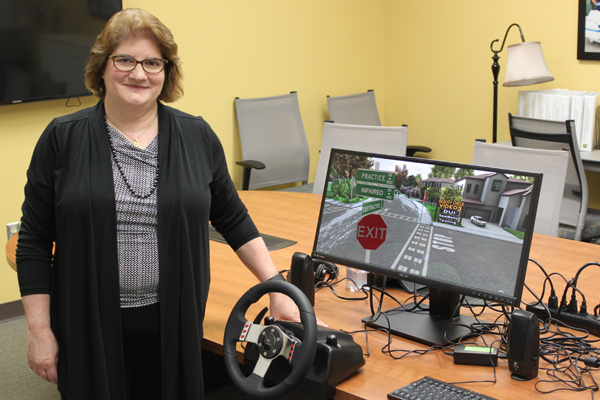UM-Flint Nursing Professor Leads Distracted Driving Research

Megan Keiser, an assistant professor of nursing at University of Michigan-Flint, settles in behind the steering wheel and pulls into the flow of traffic.
For ten minutes, she navigates through a neighborhood. A cyclist weaves in front of her. A truck drives erratically. An inattentive pedestrian starts to cross the street in front of her. She motors toward some unexpected traffic cones before switching lanes. She narrowly avoids several accidents, and feels the motion of jerking backwards after a particularly fast stop.
Finally, she purposely rear ends a parked vehicle to show the damage and consequences. Hundreds of dollars in repair bills, an insurance increase, and several weeks without her car await.
Keiser's narrow misses, and intentional crash, took place within the confines of a University of Michigan-Flint Nursing room, and not on actual roads. But the exercise proves a point, and is at the crux of inventive UM-Flint research she is leading on distracted driving.
How bad would things have gotten if she tried to drive this same route while texting, eating a sandwich, or grabbing a brush?
Keiser is implementing simulated driving into her research on whether intervention programs reduce actual distracted driving attitudes and behaviors.
"There is a lot of research being done and that has already been done that revolves around a training program, but the simulator is what makes this research unique," she said. "There are a lot of studies published about distracted driving but none of them use this technology."
Keiser is the lead researcher for the project, which received funding from a UM-Flint School of Health Professions & Studies Interprofessional Education Grant to purchase the simulator and conduct the investigation. Drs. Lenwood Hayman and Gergana Kodjebacheva, both assistant professors within the Department of Public Health and Health Sciences, are co-investigators.
This particular project will study the attitudes and behaviors of undergraduate college students, but the method could be used for other demographics in future studies, Keiser said.
"The impact we are trying to make here, in the long run, is developing a program that can be utilized in multiple forums to educate young people on the dangers of distracted driving so their behaviors will decrease, therefore decreasing the number of accidents caused by distracted driving," she said.
Keiser frequently witnesses the consequences of distracted driving, as a long-time neurosurgery nurse practitioner in a level one trauma center. This includes patients who were distracted while driving, and people who are passengers or drivers of other vehicles who are injured in accidents caused by distracted driving.
"I see the worst of the worst," she said. "Once a brain or spinal cord is injured you are going to have lifelong problems, if you even survive."
Keiser's UM-Flint research starts in the upcoming fall semester, with 100 undergraduate students participating. All of the students will complete a questionnaire about their driving habits and distracted driving behaviors at the start of the project, and again three months later. But half of these students will also complete a program, which will include a presentation on the consequences of distracted driving, and participate in the simulated driving test. The other half, the control group, will only fill out the questionnaires. The surveys will allow Keiser and her team, without identifying individuals, to see whether people's driving habits have actually changed since participating.
The simulator includes a steering wheel, brakes, turn signals, and a large screen with hyper-realistic driving scenes. The participants will be asked at various times to text with their phones, eat or drink something, and do personal grooming. The simulator includes the sounds of driving, including honking horns, yelping dogs, and squealing tires. If a participant gets in an accident, the injuries or death, and financial consequences are detailed on the screen.
"It drives the point home," Keiser said. "It's virtual reality. It's the next best thing to actual driving."
This layer of participation is unique and should build a base for other researchers, she said.
"It's definitely innovative. Any time you can do something new and different and show an impact, and that's what we are hoping to do, I think that drives people to use your methodology," she said. "And maybe not just in a research endeavor but certainly in a preventative health endeavor."
Editor's Note: This profile is the latest in our Faculty Research Spotlight series, highlighting the research of University of Michigan-Flint faculty and its benefit for our community and our world. Learn more about research at UM-Flint at umflint.edu/research. To suggest a faculty research project to spotlight, contact UM-Flint staff writer Robert Gold at goldr@umfllint.edu.
Related Posts
No related photos.
UM-Flint News
The Office of Marketing & Communications can be reached at mac-flint@umich.edu.